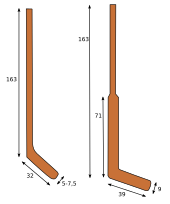Ice hockey stick

The ice hockey stick is the game device in ice hockey (and inline hockey ), which is usually used for shooting, passing and guiding, with goalkeepers in addition to fending off the puck .
shape
Ice hockey sticks are usually 150 to 200 cm long and, similar to their counterparts in the related sports of hockey , roller hockey or inline hockey , consist of a long handle and an angled element at the lower end.
This blade is the part of the club with which the puck is played and is 25 to 40 cm long. Depending on the size and preferences, however, the club dimensions can differ significantly from one another. The blade protrudes from the club shaft at a 135-degree angle, which gives the gaming device an L-shaped shape. It is also bent either slightly to the left or to the right in order to be able to lift the puck off the ice surface.
The goalkeeper's stick differs from that of an outfield player in several ways. The lower part of the shaft is wider in order to be able to repel shots better, the angle between the blade and the shaft is slightly smaller and the blade is slightly bent in the direction of play.
history

Ice hockey sticks were initially made mainly from maple , hornbeam or willow wood , similar to golf clubs or tools . After the supply of hornbeam could no longer be guaranteed, more expensive hardwoods such as yellow birch or ash were also used for production. Ash wood quickly became the preferred material, and in the 1920s, clubs made from a single piece of ash wood were the norm in gaming. The ash batons were relatively heavy, but at the same time very durable. For example , Nate Eliegh , a member of the Hockey Hall of Fame, used only one stick throughout his career.
Since the 1920s there have been some crucial advancements in the field of ice hockey sticks. The most important innovation was the development of layered rackets in the 1940s, when different layers of wood were glued together for the first time in order to make the playground equipment more flexible and durable. In the 1960s, another layer of fiberglass or other synthetic materials was introduced as a coating. In addition, the bend of the trowel became the rule, which significantly changed the physical properties of shots.
In the 1970s, cricket and baseball bat manufacturers began producing playground equipment made from lightweight steel alloys to replace the common willow or ash wood. The ice hockey stick industry followed suit in the 1980s by first presenting a one-piece aluminum stick. However, this model could not prevail, whereupon a combination of an aluminum shaft and a wooden trowel was developed. For the first time, these constructions replaced the usual wooden clubs to a large extent.
In recent years, both aluminum and wooden clubs have gradually been replaced by more advanced products made from composite materials . The most common materials include fiberglass and carbon fiber reinforced plastic . Ice hockey sticks made of Kevlar were also developed. Clubs made from the current materials are characterized by a lower weight than their aluminum predecessors and easier production compared to wooden clubs, but they are also more expensive and less stable.
materials

Today's rackets consist of one or a combination of the following materials:
reception
The shape of the ice hockey stick is used to describe a shape and can be found in the hockey stick diagram , hockey stick phenomenon , in the hockey chin (an angular chin line on the face) and in the Saab Hockey Stick (a window line on cars of the Swedish brand Saab ).


